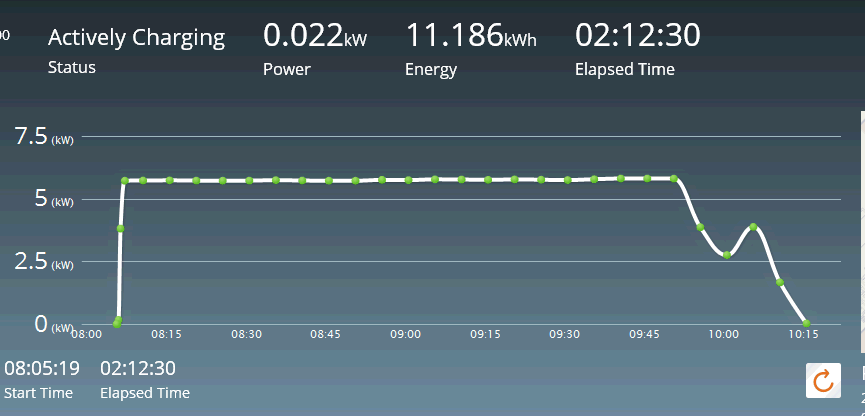v_traveller
Well-known member
Good data! Have you ever measured battery temperature at the tail end of a full charge session? I've noticed the TMS running on several different charging sessions when near full charge, both at L1 and L2.

Excellent observations, dmen. Now, again, I have a 60-mile round-trip commute, so I was planning on plugging in at work for a six-to-eight hour, 120V charge to "guarantee" my trip home. If battery longevity is my top priority, maybe it's best that I should just try to make the 60-mile commute on a single home-charge (it's often only 72-degrees or lower where I live)?dmen said:Exactly. Particularly that second point- charging batteries while hot is bad for battery longevity. More accurately charging or discharging a hot battery will shorten its lifespan faster than charging or discharging a cool battery . . . Just being hot, if no energy is going in or out of batteries, is not a particularly big deal. Which is why I think remote starting the car that can't be plugged in to keep battery cool is a waste of time.studio460 said:• Storing Li-ion batteries at 100% charge.
• Charging batteries while the batteries are hot ("smart" chargers typically prevent this from occurring).
• High number of charge cycles.
The longevity of the car's battery should be much longer than your experience with smaller, highly-utilized batteries might suggest. The battery in the FFE is not "cycled" as severely as your models and tools.fbitz777 said:First that would mean 1000+ recharge cycles which from what I read from Lion/Lipo battery technology is a LOT of cycles. I own a lot of tools and model airplanes with high performance Lipo and 100s of cycles is about the limit. Given the recommendations on this thread it would be more like 2000 cycles.

So is the fan running for the AC for the cabin or for the TMS? When I heard the fan running the car was not cooling the cabin. I'm quite used to hearing the AC running when the car is preconditioning because we hear that almost every time we go down to leave. This seemed like a different & much louder fan noise.jmueller065 said:That was the radiator fan. Open the hood when its running and you can clearly see it. You can open the doors, hood, etc. while its doing the precondition and it won't stop. The only ways the precondition will stop is to either start the car, pull the plug, or delete the go times.
I've found that sometimes the car "forgets" about the go times but then remembers them if I open a door. I'll frequently load up the car for my commute about 5-15 minutes before I leave. Sometimes when I'm only 5 minutes before the go time and the car has forgot, the fan and everything immediately kicks on when I open the door (granted in some instances my timing may be perfect and it just decided at that time to do the precondition).
From your description, my guess is that it's the TMS. By the end of a charge cycle the battery accumulates heat that, depending on ambient temperature, may elevate high enough to trigger the TMS. Also, I thought I read somewhere that charging at nearly full capacity generates more heat. Below is a screenshot of when the TMS went on in my FFE at the end of a charge cycle, ambient was 81F:hybridbear said:So is the fan running for the AC for the cabin or for the TMS? When I heard the fan running the car was not cooling the cabin. I'm quite used to hearing the AC running when the car is preconditioning because we hear that almost every time we go down to leave. This seemed like a different & much louder fan noise.

fbitz777 said:First that would mean 1000+ recharge cycles which from what I read from Lion/Lipo battery technology is a LOT of cycles. I own a lot of tools and model airplanes with high performance Lipo and 100s of cycles is about the limit. Given the recommendations on this thread it would be more like 2000 cycles.
fbitz777 said:Second 7 years is a lot of time for any battery to last.
We think... however, there is no long-term evidence (specific for the FFE) to suggest this is true.jeffand said:In Example 1 the owner will see the capacity of the battery reduced at faster rate than example 2.
WattsUp said:We think... however, there is no long-term evidence (specific for the FFE) to suggest this is true.jeffand said:In Example 1 the owner will see the capacity of the battery reduced at faster rate than example 2.
I didn't say they were different... just treated differently.michael said:I have no reason to believe that FFE batteries are different in this respect than all other lithium batteries of which I am aware.WattsUp said:We think... however, there is no long-term evidence (specific for the FFE) to suggest this is true.jeffand said:In Example 1 the owner will see the capacity of the battery reduced at faster rate than example 2.
That's a bummer! Do you know if they kept it charged to 100% SOC or 80% SOC? I thought the older LEAFs had that option available.michael said:By contrast, I have two friends with severely degraded Leafs.
One was just returned after a three year lease, 22,000 miles and range well under 50 miles. It was garage-kept in Beverly Hills. The problem was that they kept it charged all the time.
Enter your email address to join: